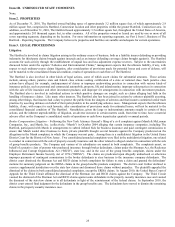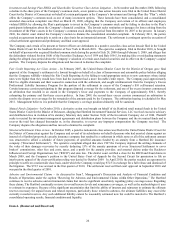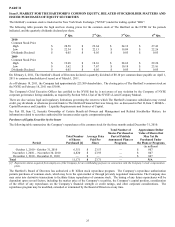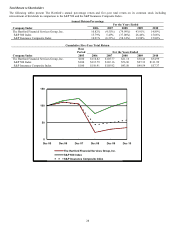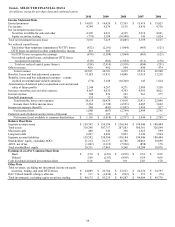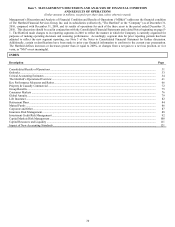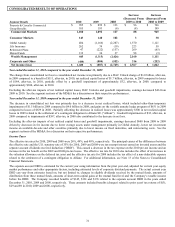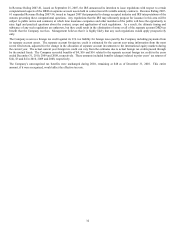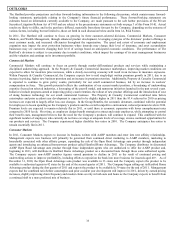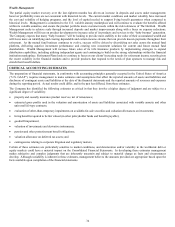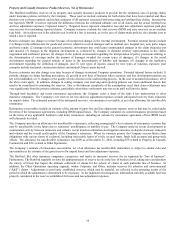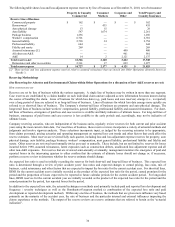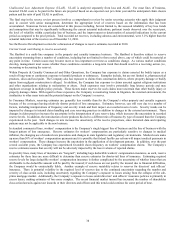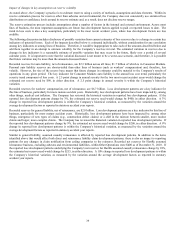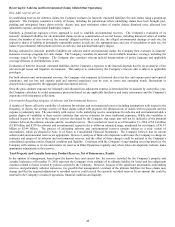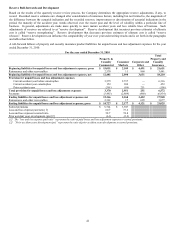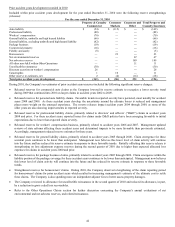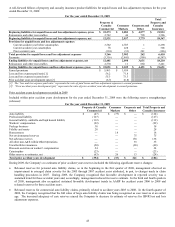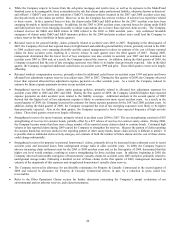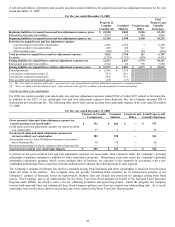The Hartford 2010 Annual Report Download - page 35
Download and view the complete annual report
Please find page 35 of the 2010 The Hartford annual report below. You can navigate through the pages in the report by either clicking on the pages listed below, or by using the keyword search tool below to find specific information within the annual report. 35
Property and Casualty Insurance Product Reserves, Net of Reinsurance
The Hartford establishes reserves on its property and casualty insurance products to provide for the estimated costs of paying claims
under insurance policies written by the Company. These reserves include estimates for both claims that have been reported and those
that have not yet been reported, and include estimates of all expenses associated with processing and settling these claims. Incurred but
not reported (“IBNR”) reserves represent the difference between the estimated ultimate cost of all claims and the actual reported loss
and loss adjustment expenses (“reported losses”). Reported losses represent cumulative loss and loss adjustment expenses paid plus
case reserves for outstanding reported claims. Company actuaries evaluate the total reserves (IBNR and case reserves) on an accident
year basis. An accident year is the calendar year in which a loss is incurred, or, in the case of claims-made policies, the calendar year in
which a loss is reported.
Reserve estimates can change over time because of unexpected changes in the external environment. Potential external factors include
(1) changes in the inflation rate for goods and services related to covered damages such as medical care, hospital care, auto parts, wages
and home repair; (2) changes in the general economic environment that could cause unanticipated changes in the claim frequency per
unit insured; (3) changes in the litigation environment as evidenced by changes in claimant attorney representation in the claims
negotiation and settlement process; (4) changes in the judicial environment regarding the interpretation of policy provisions relating to
the determination of coverage and/or the amount of damages awarded for certain types of damages; (5) changes in the social
environment regarding the general attitude of juries in the determination of liability and damages; (6) changes in the legislative
environment regarding the definition of damages; and (7) new types of injuries caused by new types of injurious exposure: past
examples include lead paint, construction defects and tainted Chinese-made drywall.
Reserve estimates can also change over time because of changes in internal Company operations. Potential internal factors include (1)
periodic changes in claims handling procedures; (2) growth in new lines of business where exposure and loss development patterns are
not well established; or (3) changes in the quality of risk selection in the underwriting process. In the case of assumed reinsurance, all of
the above risks apply. In addition, changes in ceding company case reserving and reporting patterns can create additional factors that
need to be considered in estimating the reserves. Due to the inherent complexity of the assumptions used, final claim settlements may
vary significantly from the present estimates, particularly when those settlements may not occur until well into the future.
Through both facultative and treaty reinsurance agreements, the Company cedes a share of the risks it has underwritten to other
insurance companies. The Company’ s net reserves for loss and loss adjustment expenses include anticipated recovery from reinsurers
on unpaid claims. The estimated amount of the anticipated recovery, or reinsurance recoverable, is net of an allowance for uncollectible
reinsurance.
Reinsurance recoverables include an estimate of the amount of gross loss and loss adjustment expense reserves that may be ceded under
the terms of the reinsurance agreements, including IBNR unpaid losses. The Company calculates its ceded reinsurance projection based
on the terms of any applicable facultative and treaty reinsurance, including an estimate by reinsurance agreement of how IBNR losses
will ultimately be ceded.
The Company provides an allowance for uncollectible reinsurance, reflecting management’ s best estimate of reinsurance cessions that
may be uncollectible in the future due to reinsurers’ unwillingness or inability to pay. The Company analyzes recent developments in
commutation activity between reinsurers and cedants, recent trends in arbitration and litigation outcomes in disputes between reinsurers
and cedants and the overall credit quality of the Company’ s reinsurers. Where its contracts permit, the Company secures future claim
obligations with various forms of collateral, including irrevocable letters of credit, secured trusts, funds held accounts and group-wide
offsets. The allowance for uncollectible reinsurance was $290 as of December 31, 2010, including $79 related to Property & Casualty
Commercial and $211 related to Other Operations.
The Company’ s estimate of reinsurance recoverables, net of an allowance for uncollectible reinsurance, is subject to similar risks and
uncertainties as the estimate of the gross reserve for unpaid losses and loss adjustment expenses.
The Hartford, like other insurance companies, categorizes and tracks its insurance reserves for its segments by “line of business”.
Furthermore, The Hartford regularly reviews the appropriateness of reserve levels at the line of business level, taking into consideration
the variety of trends that impact the ultimate settlement of claims for the subsets of claims in each particular line of business. In
addition, the Other Operations operating segment, within Corporate and Other, includes reserves for asbestos and environmental
(“A&E”) claims. Adjustments to previously established reserves, which may be material, are reflected in the operating results of the
period in which the adjustment is determined to be necessary. In the judgment of management, information currently available has been
properly considered in the reserves established for losses and loss adjustment expenses.


